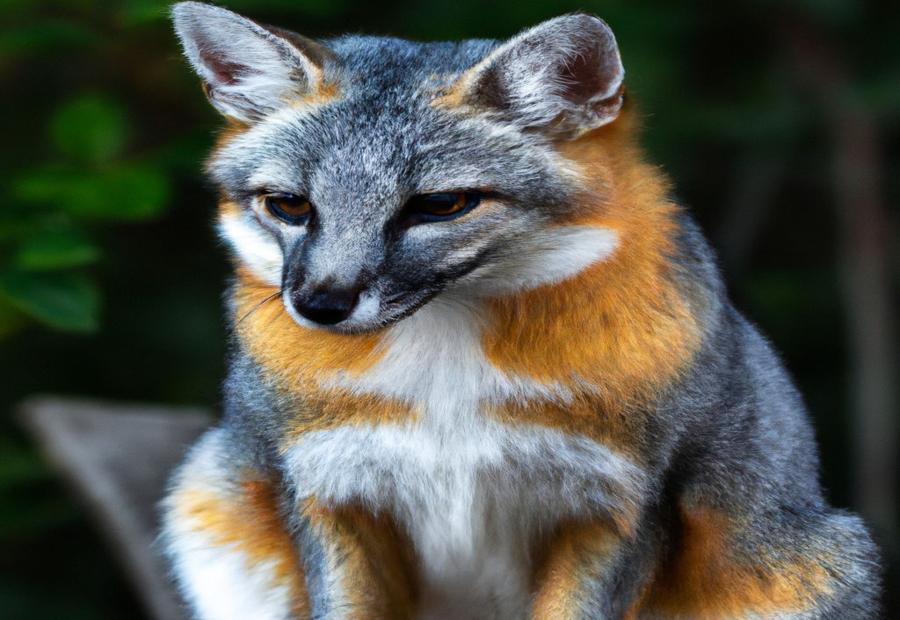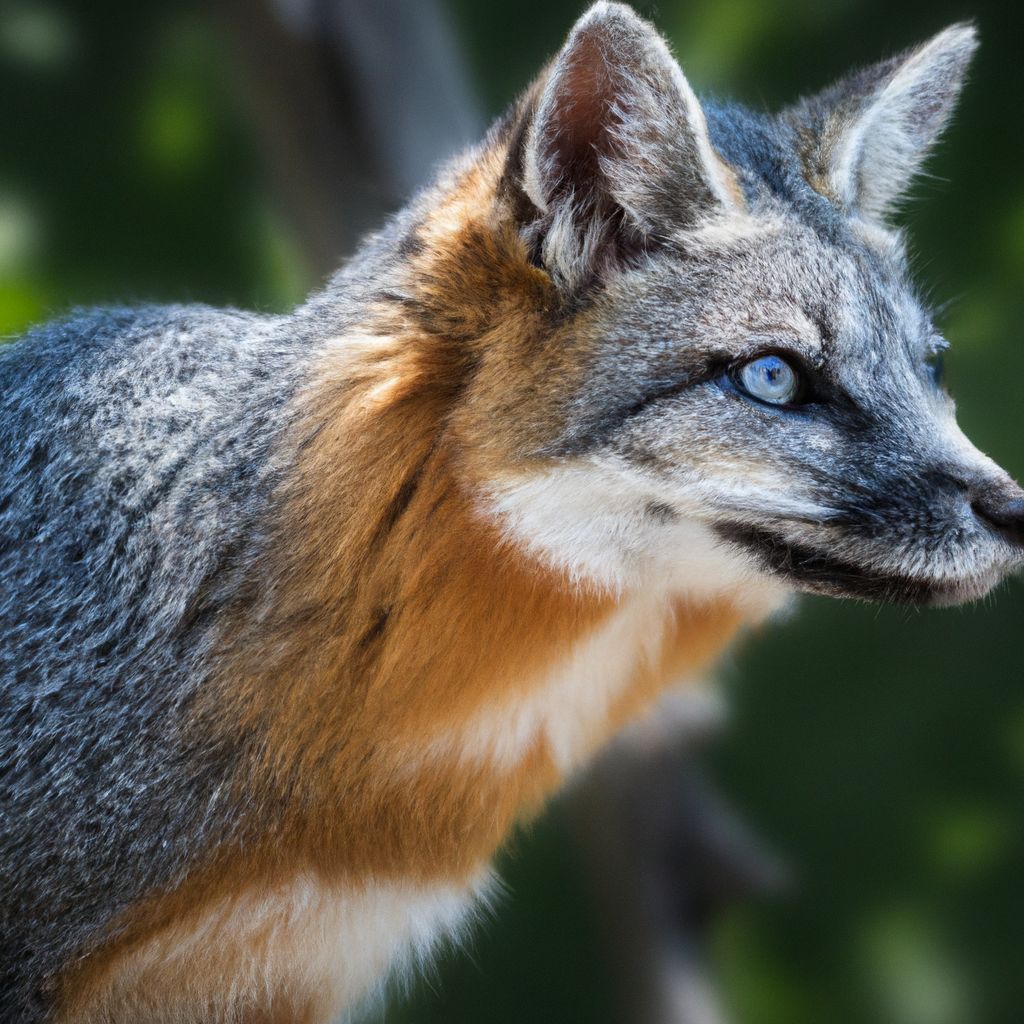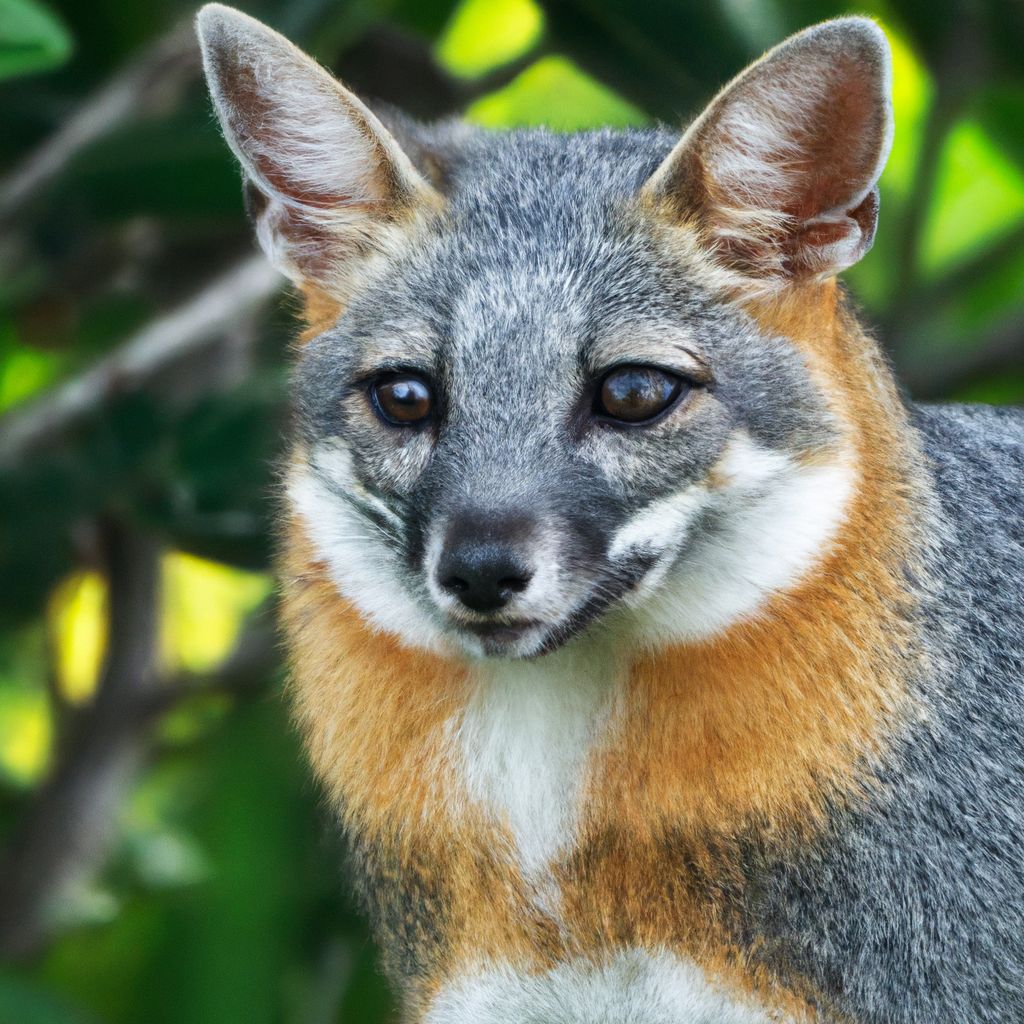The gray fox is a fascinating and elusive species that has piqued the curiosity of researchers and wildlife enthusiasts alike. A comprehensive study of its physiology and health provides valuable insights into the characteristics, adaptations, reproductive system, common diseases, conservation efforts, and future research directions involving gray foxes. This article will delve into the various aspects of gray fox biology and offer a deeper understanding of this enigmatic creature.
The Gray Fox: Introduction and Background
The gray fox (Urocyon cinereoargenteus) is a species of canid found in North and Central America. Known for its beautiful gray fur with rust-colored patches, the gray fox possesses unique characteristics and adaptations that distinguish it from other fox species. Its agility, intelligence, and ability to climb trees set it apart in the canid family.
The Physiology of Gray Foxes
Gray foxes exhibit intriguing physiological features that allow them to survive and thrive in their ecosystem. Their physical appearance and characteristics, including their size, weight, fur coloration, and sensory adaptations, contribute to their evolutionary success. Their reproductive system plays a crucial role in the perpetuation of their species.
1. Physical Appearance and Characteristics
The gray fox displays a distinctive combination of gray, rusty red, and white fur, making it easily identifiable. It possesses a lean and agile body structure, characterized by a bushy tail, pointed ears, and sharp claws, which aid in its climbing and hunting abilities.
2. Adaptations for Survival
Gray foxes have evolved several adaptations that enable them to adapt and survive in various environments. These include their remarkable climbing skills, keen senses of sight and hearing, and an omnivorous diet that allows them to be flexible in their food choices.
3. Reproductive System
The reproductive system of gray foxes is vital for the continuation of their species. Understanding their mating habits, gestation period, litter size, and parental care provides valuable insights into their denning behavior.
The Health of Gray Foxes
Like any wild animal, gray foxes face various health challenges in their natural habitat. This section will shed light on the common diseases and conditions that affect them, their immune system and disease resistance mechanisms, as well as the parasites and parasitic infections that can impact their well-being.
1. Common Diseases and Conditions
Gray foxes are susceptible to a range of diseases and conditions, including viral, bacterial, and parasitic infections. Understanding these health issues is crucial for monitoring and conserving gray fox populations.
2. Immunology and Disease Resistance
The immune system of gray foxes plays an essential role in combating pathogens and maintaining their health. Exploring their immunology and disease resistance mechanisms can provide valuable insights into their ability to withstand various infectious agents.
3. Parasites and Parasitic Infections
Parasites pose a constant threat to gray foxes, affecting their overall health and well-being. Studying the prevalence and impact of parasites on these animals can contribute to effective management and conservation strategies.
Conservation and Management of Gray Foxes
The gray fox population faces various threats that warrant conservation efforts. This section will explore the challenges they encounter, the ongoing conservation initiatives aimed at ensuring their survival, and the role of captivity and rehabilitation in their management.
1. Threats to Gray Fox Populations
Human activities, habitat loss, fragmentation, and conflicts with other species pose significant threats to gray fox populations. Identifying and mitigating these threats is crucial for their long-term survival.
2. Conservation Efforts
Various organizations and researchers are actively involved in conserving gray foxes through habitat preservation, education, and implementing conservation strategies. Highlighting these efforts can inspire further action and awareness.
3. Captivity and Rehabilitation
The role of captivity and rehabilitation in conserving gray foxes is worth exploring. Examining the ethical and practical considerations of captive breeding and rehabilitation programs provides insights into their impact on the conservation of this species.
Conclusion: Insights and Future Research Directions
A comprehensive study of the physiology and health of gray foxes has shed light on their unique attributes, health challenges, and conservation needs. However, there are still many avenues for future research, including exploring their behavior, diet, habitat requirements, and the effect of human disturbances on their populations. By continuing to delve deeper into the lives of gray foxes, we can expand our knowledge and contribute to their long-term survival and well-being.
Contents
- 1 Key takeaway:
- 2 The Physiology of Gray Foxes
- 3 The Health of Gray Foxes
- 4 Conservation and Management of Gray Foxes
- 5 Frequently Asked Questions
- 5.1 Question 1: What are the physical characteristics of a gray fox?
- 5.2 Answer 1:
- 5.3 Question 2: How big can gray foxes grow?
- 5.4 Answer 2:
- 5.5 Question 3: Where can gray foxes be found?
- 5.6 Answer 3:
- 5.7 Question 4: Do gray foxes have any unique behaviors?
- 5.8 Answer 4:
- 5.9 Question 5: What do gray foxes eat?
- 5.10 Answer 5:
- 5.11 Question 6: How do gray foxes store excess food?
- 5.12 Answer 6:
Key takeaway:
- The Gray Fox: A Comprehensive Study of Its Physiology and Health
- Physiology of Gray Foxes: Understanding the physical appearance, characteristics, and reproductive system of gray foxes is crucial to comprehend their behavior and adaptation for survival in various environments.
- Health of Gray Foxes: Understanding and addressing common diseases, immunology, disease resistance, as well as parasites and parasitic infections in gray foxes is important for their conservation and management.
- Conservation and Management: Recognizing threats to gray fox populations, implementing conservation efforts, and promoting captivity and rehabilitation programs are essential for the survival and well-being of these species.
- Conclusion: Insights and Future Research: Conducting further research to expand knowledge about gray foxes will provide valuable insights for their ecological preservation and shed light on potential future research directions.
The Physiology of Gray Foxes
Gray foxes, fascinating creatures inhabiting diverse ecosystems, have captivated scientists and nature enthusiasts alike. In this section, we delve into the mysterious physiology of gray foxes, uncovering their physical appearance, unique adaptations for survival, and the intricate workings of their reproductive system. Brace yourself for a captivating journey into the realm of these remarkable creatures, as we unravel the secrets behind their fascinating anatomy and delve into the marvels of their sustainable existence.
Physical Appearance and Characteristics
The gray fox, known for its physical appearance and characteristics, can be described as follows. These small creatures have a body length of 32-45 inches (81-114 cm) and a tail measuring 11-16 inches (28-41 cm). Their fur is gray to grayish-brown on the back, with lighter undersides ranging from white to yellowish-brown. The fur itself is dense and fluffy, providing insulation against cold temperatures and sporting a slightly black-tipped appearance. One distinctive feature of gray foxes is the presence of a black stripe running down the length of their tail.
In terms of facial features, they possess a pointed muzzle, black nose, and dark brown or black eyes. Their ears play a vital role in their excellent hearing abilities as they are large and pointed, capable of rotating 180 degrees. When it comes to weight, adult gray foxes typically weigh between 7-15 pounds (3-7 kg), with males being slightly larger than females.
These agile climbers also possess retractable claws, allowing them to navigate trees with ease. In fact, it is worth noting that the gray fox is the only member of the dog family with this remarkable ability.
Adaptations for Survival
Adaptations for survival in gray foxes are diverse and encompass various aspects of their physical characteristics, hunting strategies, and behavior. One notable adaptation is their natural camouflage, as gray foxes possess a distinctive coat coloration that enables them to blend seamlessly with their surroundings. This ability aids them in evading predators and stealthily approaching their prey.
Another significant adaptation is their climbing ability. Unlike many other fox species, gray foxes have the remarkable capability to climb trees. This allows them to seek refuge from predators when necessary, as well as find shelter and safety in elevated areas.
Gray foxes also exhibit exceptional ambush hunting skills. With their sharp hearing and flexible bodies, they are adept at stalking and pouncing on their prey. This proficiency, combined with their keen senses, enables them to effectively hunt and secure their sustenance.
The omnivorous diet of gray foxes further contributes to their survival. They have the adaptability to consume a variety of food sources, including small mammals, birds, fruits, and insects. This dietary flexibility allows them to thrive in diverse environments and adapt to different seasons.
Furthermore, gray foxes display predominantly nocturnal behavior. By being most active during the night, they avoid direct competition with predators and minimize encounters with humans. This behavioral adaptation is essential for their survival in their natural habitats.
In addition to these adaptations, gray foxes possess a strong sense of smell and remarkable agility, which further enhance their survival capabilities in their respective ecosystems.
It is also worth mentioning an intriguing fun fact about gray foxes: they have the unique ability to rotate their forelimbs. This remarkable adaptation enables them to climb down trees headfirst, distinguishing them from most other members of the Canidae family.
Overall, gray foxes have evolved a range of adaptations in order to survive successfully in their environments, allowing them to effectively navigate challenges and thrive in diverse habitats.
Reproductive System
The reproductive system of gray foxes is crucial for the survival of their species. Gray foxes have a well-developed reproductive system that facilitates mating and the production of offspring. Females undergo a yearly reproductive cycle known as estrous, during which they become receptive to mating and release eggs for fertilization.
Mating behavior in gray foxes involves using scent marking and vocalizations to attract potential mates. Males engage in competition for dominance and the opportunity to mate with females.
After a successful mating, female gray foxes experience a gestation period of approximately 53 days. They give birth to litters of one to seven pups, with an average litter size of three to four. The newborn pups are born blind and rely on their mother for care and nourishment.
The responsibility of raising the offspring primarily falls on the female gray fox, who provides milk and protection from predators until the pups can fend for themselves. The male may contribute by assisting with hunting and safeguarding the den.
The reproductive system of gray foxes plays a vital role in ensuring the continuity of their species. Successful reproduction leads to population growth and genetic diversity.
Understanding the reproductive system of gray foxes is essential for the conservation and management of their populations. Conducting research on their reproductive behavior and success rates helps establish strategies to safeguard and preserve this captivating species.
The Health of Gray Foxes

Photo Credits: Foxauthority.Com by Philip Mitchell
Gray foxes are fascinating creatures, but what about their health? In this section, we’ll dive into the well-being of gray foxes, exploring common diseases and conditions, their remarkable immunology and disease resistance, as well as the challenges they face with parasites and parasitic infections. Get ready to uncover the intricacies of their health and gain a deeper understanding of these resilient creatures.
Common Diseases and Conditions
Common diseases and conditions that affect gray foxes include:
- Canine distemper: A viral disease affecting the respiratory, gastrointestinal, and nervous systems. It can be fatal and transmitted through contact with infected animals.
- Sarcoptic mange: A skin disease caused by parasitic mites. It can cause severe itching, hair loss, and skin lesions.
- Rabies: A viral disease affecting the central nervous system. It can be transmitted through bites from infected foxes to humans and other animals.
- Parvovirus: A highly contagious viral disease affecting the gastrointestinal tract. It can cause severe vomiting, diarrhea, and dehydration.
- Lyme disease: A bacterial infection transmitted through tick bites. It can cause fever, joint pain, and fatigue.
- Internal parasites: Foxes can be affected by roundworms, hookworms, and tapeworms. These parasites can cause gastrointestinal issues and nutrient deficiencies.
- External parasites: Foxes can also be infested with fleas, ticks, and mites, which can cause skin irritation and transmit diseases.
To prevent and manage these common diseases and conditions in gray fox populations, it is important to implement measures such as vaccination programs, regular veterinary care, and tick control. Additionally, promoting habitat conservation and minimizing interactions between foxes and domestic pets can help reduce the spread of diseases. Ongoing research and monitoring of disease prevalence in gray foxes can provide valuable insights for conservation and management.
Immunology and Disease Resistance
Immunology and Disease Resistance are crucial for the health of Gray Foxes.
The immune system of Gray Foxes efficiently protects them against diseases and infections. They have diverse immune cells, including lymphocytes and macrophages, which identify and destroy pathogens. Gray Foxes have natural resistance to certain diseases like canine distemper and rabies. Their immune response is adaptive, recognizing and remembering specific pathogens for long-lasting protection.
Disease resistance also depends on the overall health and condition of the Gray Fox population. A healthy population with a diverse gene pool is more resilient to diseases. However, habitat loss and pollution weaken the immune system of Gray Foxes, making them more susceptible to diseases.
Maintaining the immunological well-being of Gray Fox populations requires vaccination programs and monitoring the spread of diseases. Ongoing research is essential to understand the immunology of Gray Foxes and develop strategies to enhance disease resistance and conservation efforts. Immunity is crucial for the survival and health of these creatures.
Parasites and Parasitic Infections
Parasites and parasitic infections are common concerns for gray fox health. These parasites can cause health issues and negatively impact the overall well-being of the fox population. Understanding the types of parasites that affect gray foxes and the potential consequences is essential.
One common parasite that affects gray foxes is the Sarcoptes scabiei mite, causing mane. This condition leads to hair loss, itching, and skin irritation. Another parasite is the fox tapeworm, Echinococcus multilocularis, which can infect foxes and other mammals, including humans. This tapeworm can cause serious health problems, such as organ damage and cyst formation.
To prevent and manage parasitic infections in gray foxes, regular veterinary care is crucial. Veterinarians may prescribe appropriate antiparasitic treatments and recommend preventive measures, like controlling flea and tick populations in the fox’s habitat. It is also important to educate the public about the risks of interacting with foxes and the importance of practicing good hygiene to minimize parasite transmission.
Fact: Around 65% of gray foxes in certain populations are affected by mane, highlighting the importance of addressing parasites and parasitic infections to ensure the health and survival of these creatures.
Conservation and Management of Gray Foxes
Gray foxes are unique creatures that require careful attention to their conservation and management. In this section, we dive into the pressing challenges faced by gray fox populations, the dedicated efforts being made to protect them, and the important role of captivity and rehabilitation in their preservation. From understanding the threats they face to exploring the bold steps taken to ensure their survival, this exploration sheds light on the vital conservation and management strategies necessary for the wellbeing of gray foxes.
Threats to Gray Fox Populations
1. Habitat loss: Gray fox populations face significant challenges due to human activities like deforestation, urbanization, and agricultural expansion. These activities destroy or fragment their natural habitats, making it difficult for gray foxes to find suitable areas for foraging, denning, and raising their young.
2. Hunting and trapping: Gray foxes are hunted and trapped primarily for their fur, which puts immense pressure on their populations. Unregulated hunting and trapping practices can lead to a significant decline in gray fox numbers, especially in regions where they are specifically targeted for their pelts.
3. Road mortality: Gray foxes often fall victim to vehicle collisions while attempting to cross roads. With the expansion of urban areas and an increase in road networks, the risk of gray foxes being struck by vehicles has significantly risen, resulting in population declines.
4. Competition with other species: Gray foxes face competition for food and resources from both native and invasive species, such as coyotes and red foxes. This competition limits their access to prey and suitable habitats, thereby impacting their population size and distribution.
5. Disease and parasites: Gray fox populations are susceptible to various diseases and parasites, including mange, rabies, and ticks. Disease outbreaks can have a significant impact on gray fox populations, causing mortality and reducing their reproduction rates.
To mitigate these threats, it is crucial to conserve gray foxes’ natural habitats, establish protected areas, and implement sustainable hunting and trapping practices. Efforts should also focus on reducing road mortality by constructing wildlife crossings and educating the public about the importance of wildlife conservation. Furthermore, monitoring and managing disease outbreaks and controlling invasive species can contribute to the protection of gray fox populations. Addressing these threats is essential to ensure a healthier future for gray foxes and maintain ecosystem balance.
Please note that while this text provides information about the threats to gray fox populations, it is important to refer to the original article for a comprehensive study of the physiology and health of gray foxes in order to gain a more detailed understanding of their conservation needs and management strategies.
Conservation Efforts
Conservation efforts play a vital role in protecting and preserving gray fox populations. These efforts are aimed at ensuring the long-term survival of the species and maintaining a healthy ecosystem. Here are some key components of conservation efforts:
1. Habitat preservation: The protection of gray foxes’ natural habitats is of utmost importance. This includes the preservation of forests, woodlands, and grasslands where they thrive. It is crucial to prevent habitat loss caused by urbanization and deforestation.
2. Habitat restoration: In areas where gray fox habitats have suffered degradation or destruction, measures are taken to restore them. This involves replanting native vegetation, creating wildlife corridors, and restoring water sources.
3. Addressing threats: Identifying and mitigating threats to gray fox populations is essential for their conservation. Efforts are made to reduce hunting and trapping, minimize conflicts with humans, and prevent road accidents. For more information, you can visit The Gray Fox: A Detailed Examination of Its Role in Wildlife Education.
4. Education and awareness: A fundamental aspect of conservation efforts is increasing public awareness about gray foxes and their significance in the ecosystem. Educating communities about the benefits of conserving wildlife and promoting responsible behavior towards these animals can significantly contribute to their conservation. For more information about the gray fox and its diet and hunting techniques, visit this comprehensive study.
5. Collaboration and research: Conservation organizations, researchers, and government agencies collaborate to gather scientific data on gray fox populations. This data helps implement effective conservation strategies and monitor the species’ population status and trends.
To further enhance conservation efforts for gray foxes, it is crucial to involve local communities in wildlife conservation initiatives, support funding for research and conservation projects, and prioritize the protection of natural habitats.
Captivity and Rehabilitation
Captivity and rehabilitation are essential components of gray fox conservation. The process of captivity entails the responsible containment of gray foxes in controlled environments, such as wildlife rehabilitation facilities or sanctuaries. Rehabilitation facilities offer essential care and support to injured or orphaned gray foxes, with the ultimate objective of reintroducing them to their natural habitats.
These practices play a vital role in bolstering gray fox populations by rescuing and providing aid to injured or displaced individuals, thus ensuring their overall well-being. By rehabilitating gray foxes, we restore their physical health and prepare them for a successful return to their native environments.
Through the implementation of captivity and rehabilitation programs, numerous gray foxes have been saved and successfully reintroduced into suitable habitats. These concerted efforts serve to increase both the population numbers and genetic diversity of this magnificent species.
It is crucial to exercise caution and only pursue captivity and rehabilitation when there is an authentic need and when the prospect of releasing individuals back into the wild is feasible. The welfare and best interests of the gray foxes should always remain the top priority in these conservation efforts.
By incorporating the practices of captivity and rehabilitation into gray fox conservation strategies, we actively contribute to the overall well-being and long-term survival of this species, thus ensuring a brighter future for them in the wild.
Frequently Asked Questions
Question 1: What are the physical characteristics of a gray fox?
The gray fox is a medium-sized fox with short legs, a thin black line of fur from their eye to the side of their head, and fur that is a mix of white, black, gray, and red.
Answer 1:
The gray fox is a medium-sized fox with short legs and fur that is a mix of white, black, gray, and red. They have a thin black line of fur from their eye to the side of their head.
Question 2: How big can gray foxes grow?
The biggest gray foxes can weigh almost 20 pounds.
Answer 2:
The biggest gray foxes can weigh almost 20 pounds.
Question 3: Where can gray foxes be found?
Gray foxes can be found in North and South America, excluding the mountains of the Northwest and the Great Plains. They prefer bushy woodland areas and forests near water.
Answer 3:
Gray foxes can be found in North and South America, excluding the mountains of the Northwest and the Great Plains. They prefer bushy woodland areas and forests near water.
Question 4: Do gray foxes have any unique behaviors?
Yes, gray foxes are the only foxes that can climb trees. They sometimes make their dens in tree limbs and hollow trunks.
Answer 4:
Yes, gray foxes are the only foxes that can climb trees. They sometimes make their dens in tree limbs and hollow trunks.
Question 5: What do gray foxes eat?
Gray foxes are omnivores and eat both plants and meat. They hunt alone for snacks like mice, rats, rabbits, birds, insects, nuts, corn, fruits, grass, and berries. They will also eat dead animals.
Answer 5:
Gray foxes are omnivores and eat both plants and meat. They hunt alone for snacks like mice, rats, rabbits, birds, insects, nuts, corn, fruits, grass, and berries. They will also eat dead animals.
Question 6: How do gray foxes store excess food?
Gray foxes store excess food by burying it in the ground.
Answer 6:
Gray foxes store excess food by burying it in the ground.


